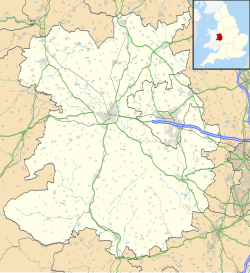All Saints Church is the Church of England parish church of Wellington in the borough of Telford and Wrekin in Shropshire, England.[1] It is in the Diocese of Lichfield,[2] and is an active place of worship and community hub for the town and outlying areas.[3][4] The church is grade II* listed,[5] and sits a short distance north of Wellington town centre, close to both the Wolverhampton–Shrewsbury line and Wellington railway station.[6]
| All Saints Church, Wellington | |
|---|---|
| All Saints Church, Wellington | |
 | |
| 52°42′07″N 2°31′04″W / 52.702042°N 2.517782°W | |
| Location | Wellington, Telford and Wrekin |
| Country | England |
| Denomination | Church of England |
| Website | www |
| History | |
| Status | Active |
| Founded | 1790 |
| Dedication | All Saints |
| Dedicated | 1758 |
| Consecrated | 1758 |
| Past bishop(s) | Edward Pryce Owen |
| Architecture | |
| Functional status | Parish Church |
| Heritage designation | Grade II* |
| Designated | April 1983 |
| Architect(s) | George Steuart |
| Style | Neoclassical |
| Completed | 1758 |
| Construction cost | £3,755.14 (1748) |
| Specifications | |
| Capacity | 300 |
| Bells | 8 (1713 - 1890) |
| Tenor bell weight | 242kg - 827kg |
| Administration | |
| Province | Canterbury |
| Diocese | Lichfield |
| Parish | Wellington |
| Clergy | |
| Vicar(s) | Revd Tim Carter |
| Priest(s) | Revd Ellie Cheetham-Wilkinson |
History
editAll Saints Church has undergone three separate rebuilds during its existence. The present building is the third incarnation of the church to occupy the same site as the previous two incarnations over the past thousand years.[7][unreliable source?] The original church building existed until the outbreak of the English Civil War and was subsequently destroyed by both Oliver Cromwell and Charles II's men.[8] It was not until 1740 and 1748 that a new church was considered for the site of the then-destroyed church.[9] The existing church was built around 1790 and was once served by Edward Pryce Owen in 1802, who became the bishop of the church for a time from 1823 until 1841.[10] The church underwent slight refurbishments and extensions in 1898.[11] The church was given Grade II* listed status by Historic England in April 1983.[5] In 2017, the church was one of many parish churches across the United Kingdom to take part in the BBC's Music Day UK by ringing the bells.[12]
Architecture
editThe church was designed by George Steuart in Neoclassical style. It is built in Grinshill stone, a type of sandstone, and consists of a nave with an apse and a tower behind the west front. The west front has three bays with giant Tuscan pilasters carrying a pediment. In the centre is a doorway flanked by windows, all with square heads, and above are lunettes. The tower has two stages with paired Ionic pilasters, clock faces, and a small dome. Along the sides of the church are two tiers of windows, the upper windows round-headed, and in the apse is a tripartite pilastered window. Inside the church are galleries on three sides.[13][5]
Lychgate
editThe gate piers flank the southwest entrance to the churchyard, from Church Street,[14] and were built in the late 18th or early 19th century. They are in stone, and have a panelled frieze, a moulded cornice, and a hemispherical cap. Steps flanked by coped stone walls lead up to a memorial lychgate that was added in 1922. The lychgate has stone walls, a timber superstructure with round arches, a timber framed gable with a cross finial, and a tiled roof. On the arches are inscriptions, and on the inside walls are bronze plaques with inscriptions and the names of those lost in the two World Wars.[15][16][17][page needed] The "Gate Piers, Steps, Walls and War Memorial Lychgate" are grade II listed as one entity.[18]
See also
editReferences
edit- ^ "All Saints Wellington". All Saints Wellington. Retrieved 14 January 2025.
- ^ Lichfield, Diocese of. "Find a Church". www.lichfield.anglican.org. Retrieved 14 January 2025.
- ^ "Students to perform concert in aid of church organ restoration fund". www.shropshirestar.com. 3 July 2024. Retrieved 14 January 2025.
- ^ "All Saints Parish Centre | Live Well Telford". livewell.telford.gov.uk. Retrieved 14 January 2025.
- ^ a b c Historic England. "Church of All Saints (1033317)". National Heritage List for England. Retrieved 14 January 2025.
- ^ "Find us". All Saints Wellington. 22 May 2008. Retrieved 14 January 2025.
- ^ "Giant Places - All Saints Parish Church". Wellingtons Walking With Giants. Retrieved 14 January 2025.
- ^ "Architecture". All Saints Wellington. 28 June 2010. Retrieved 14 January 2025.
- ^ "History". All Saints Wellington. 28 July 2010. Retrieved 14 January 2025.
- ^ "Wellington: Churches | British History Online". www.british-history.ac.uk. Retrieved 14 January 2025.
- ^ "General Building News: Proposed Restoration of Parish Church Wellington". The Builder. 74: 400. 23 April 1898. Retrieved 14 January 2025.
- ^ "BBC Music - BBC Music Day - Bell ringers unite for BBC Music Day". BBC. Retrieved 14 January 2025.
- ^ Newman, John; Pevsner, Nikolaus (2006), Shropshire, The Buildings of England, New Haven and London: Yale University Press, p. 653, ISBN 0-300-12083-4
- ^ "What to expect at Church". All Saints Wellington. 19 May 2010. Retrieved 14 January 2025.
- ^ "Wellington Lychgate". www.warmemorialsonline.org.uk. Retrieved 14 January 2025.
- ^ "Community: Wellington Shropshire - All Saints Lychgate War Memorial | Lives of the First World War". livesofthefirstworldwar.iwm.org.uk. Retrieved 14 January 2025.
- ^ Johnstone, Janet (30 May 2018). Shropshire at War, 1939–45. Pen and Sword. ISBN 978-1-4738-5898-5.
- ^ Historic England. "Gate Piers, Steps, Walls and War Memorial Lychgate (1033318)". National Heritage List for England. Retrieved 14 January 2025.
External links
edit- Official website
- "All Saints Churchyard". FindAGrave. As of January 2025[update] has records of 279 graves
